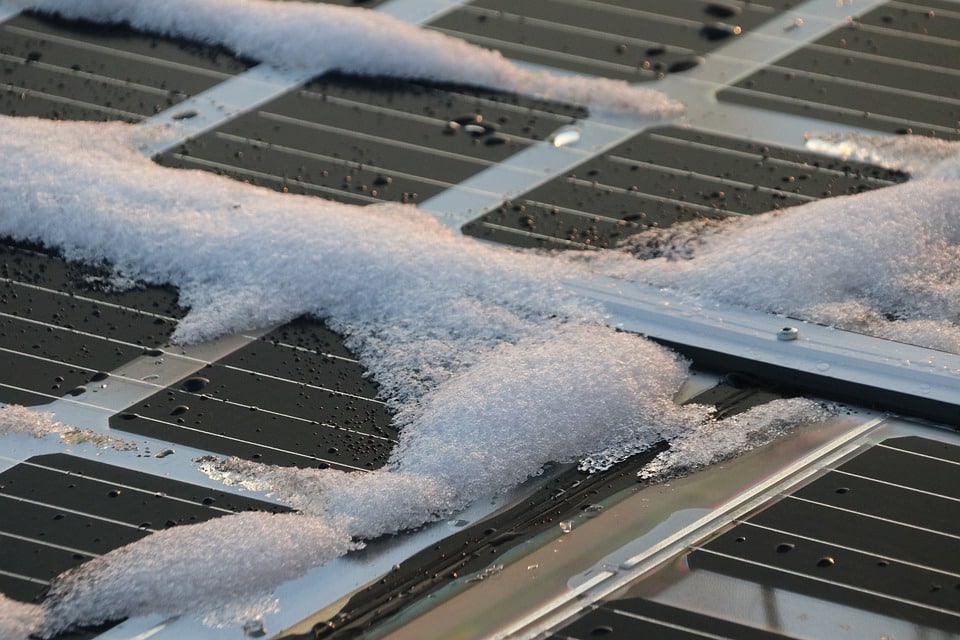Did you know three of the top 10 States for solar installation are Massachusetts, New Jersey and New York? These three states combined have an annual snowfall of nearly two hundred inches.
A common assumption about solar charging stations is that they only function properly in states with hot climates. While heavy snowfall can hinder solar performance, Sunbolt’s Solar Charging Stations are well-designed to not only handle snow fall, but also operate in extremely cold temperatures.
Will I need to clean snow off my Sunbolt Solar Charging Station?
Engineers design our solar charging stations to certify the solar canopies are sloped in a way to prevent snow build-up whilst ensuring the optimum position for gathering sunlight. With the advantage of the slope, you can allow the snow to fall off naturally via gravity or you can use a “roof rake,” which is specifically designed to remove snow from solar panels.
Be certain not to use a traditional rake or brush with stiff bristles, those options have the potential to damage your solar modules. Sunbolt uses dark solar panels on all charging stations which helps melt snow easier because dark solar panels attract heat. On average, solar panels are typically 36ºF warmer than the ambient temperature, so even with minimum sunlight, solar panels will start to warm up and melt snow.
How will my Sunbolt Solar Workstation stand up to brutal winter temperatures and extreme weather conditions including hail?
Our Solar Workstations have a wind-rating of 130-170 mph when self-ballasted, while the Solar Carousels reach a wind-rating of 185 mph when anchored. These high wind-ratings can handle some of the most extreme winds. The technology behind our battery options can operate and charge in the extreme temperatures of -40ºF to 149ºF.
Sunbolt has taken precautions to safeguard against the short winter days by utilizing advanced charge controllers and large battery banks that will allow the user hours of device charging capabilities when sunlight is not available.
Sunbolt uses solar panels that are manufactured in tier-one solar plants which are certified by UL, CE, and/or IEC (among others). They can withstand heavy snow loads up to a pressure value of 5400 Pascals (Pa) which equates to 112 pounds per square foot of snow, wind loads up to 2400 Pa, and handle hail up to 1 inch in size traveling up to 50 mph (minimum standards).
Are there any benefits to having a Solar Charging Station in cold or snowy conditions?
Solar panels actually function better in cooler weather. Warmer temperatures cause more strain on solar cells; experts say you can lose 10-25% of your voltage output. In cooler temperatures you will only lose about 3%. When a Solar Charging Station is surrounded by snow covered ground it actually performs better than it would in warmer climates.
This is due to the snow having reflective properties that may enhance what your solar panels can absorb. In fact, a snowy surrounding is among the best natural solar light reflectors available. This will allow your solar panels to harness additional reflecting light which in turn generates extra energy.
Snow can also act as a natural cleaning source for your solar modules. As the snow begins to melt, it removes dirt, dust, and built-up pollen, cleaning your solar panels and making them more efficient.
What are the major concerns with the snow on the Solar Charging Stations?
Snow will only become a concern if it is heavy enough to overtake the solar panel and cannot be brushed off. Even then, the accumulated particles will melt quicker than the snow on the rest of the area due to the radiation from the solar panel’s natural illumination; even the light that passes through the snow will assist in melting it.
Heavy snow accumulation left untreated can also cause cracks in your solar panels. Those cracks will not stop your solar panels from functioning, but it will reduce your performance. Minor cracks will have a miniscule change, but large cracks could cause a need for a replacement.
An example of what to expect from a cracked solar panel is if the solar panel is 10-20% cracked you can expect a deduction of 10-20% of the voltage’s peak performance. Sunbolt offers a maintenance plan that not only covers the standard upkeep of Sunbolt’s Solar Charging Stations, but it also covers the replacements of most major components, and inspections that include solar panel integrity.

How can I troubleshoot or monitor my device in the winter?
All of Sunbolt’s Solar Charging Stations are equipped with Bluetooth monitoring devices that will give the user the ability to see real-time system performances and make parameter changes without having to physically touch the solar modules.
If you are experiencing difficulties with your solar modules or you need immediate assistance, contact Sunbolt at 267-419-8496 between the hours of 7:30am – 5:00pm EST and one of our trained representatives will be able to assist you and/or schedule maintenance.
Concluding thoughts:
Whether you live in a state full of sunshine all year long or a state that experiences snowy winters, solar panels can still provide the service you expect. Sunbolt’s Solar Powered Workstations are above the rest with technology that will help solar modules thrive in any weather conditions.
If you have any questions about the solar potential in your state or area don’t hesitate to Contact the Sunbolt Team for more information.


